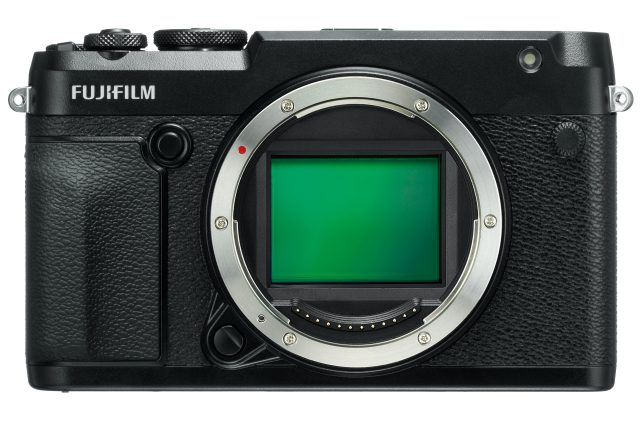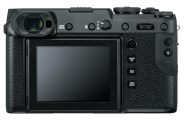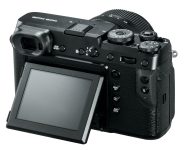Announced
Production status
System
Fujifilm GFX 50R
Medium format AF digital mirrorless camera
Specification
| Format: | |
| Medium format 44x33 | |
Imaging sensor: | 43.8 × 32.9mm CMOS sensor |
Resolution: | 8256 × 6192 - 51 MP |
Sensor-shift image stabilization: | - |
| Fujifilm G [26.7mm] | |
| Shutter: | |
Type: | Focal-plane |
Model: | Electronically controlled |
Speeds: | 3600 - 1/4000 + B |
| Exposure: | |
Exposure metering: | Through-the-lens (TTL), open-aperture |
Exposure modes: | Programmed Auto |
| Aperture-priority Auto | |
| Shutter-priority Auto | |
| Manual | |
| Physical characteristics: | |
Weight: | 775g |
Dimensions: | 160.7x96.5x66.4mm |
Manufacturer description
Valhalla, N.Y., September 25, 2018 – FUJIFILM North America Corporation today announced the new FUJIFILM GFX 50R rangefinder-style medium format mirrorless digital camera. Featuring a large 51.4MP G Format CMOS image sensor and X-Processor Pro image processing engine, the GFX 50R delivers superior image quality in a compact and lightweight body reminiscent of their renowned medium format film cameras widely used in street and documentary photography. The GFX 50R is equipped with a 0.77x3.69M-dot organic “OLED” electronic viewfinder for accurate focusing and framing images. Weighing approximately 145g less than the GFX 50S, this camera offers intuitive handling in a rugged, weather-sealed body to meet the varying needs of photographers.
“We are very excited to further expand the GFX system with the introduction of a rangefinder-style medium format camera,” says Yuji Igarashi, General Manager of the Electronic Imaging Division and Optical Devices Division of FUJIFILM North America Corporation. “The GFX 50R is a lighter and more compact model within the medium format mirrorless system, perfect for professional photographers who specialize in street, documentary or portrait photography.”
Equipped with 51.4MP Medium Format CMOS Sensor and X-Processor Pro
The GFX 50R features the FUJIFILM G Format 43.8 x 32.9mm sensor with a 51.4MP resolution and high-performance X-Processor Pro image processing engine to provide outstanding color and tone reproduction. Supporting FUJIFILM renowned Film Simulation modes, the camera allows photographers to opt for the tonality of photographic films such as Velvia, PROVIA and ACROS, used for many years in medium format film cameras by professional and enthusiast photographers alike. The micro lenses on the sensor in the new GFX 50R have been designed to optimize light gathering performance and image resolution to deliver images that precisely reproduce the subject’s texture, three-dimensional feel and even the atmosphere of each scene.
Intuitive Handling and Rugged Body to Meet Photographer Needs
Featuring a robust magnesium alloy body, the GFX 50R is weather-sealed in 64 places, designed to be weather- and dust-resistant, and capable of operating in temperatures as low as 14 degrees Fahrenheit \ -10 degrees Celsius. The GFX 50R is also built for intuitive operation. Equipped with a Focus Lever to allow quick focal point adjustment, the GFX 50R eliminates selector buttons to provide extra space for comfortably holding the camera. The top of the body sports two dials – for shutter speed and exposure compensation – constructed of milled aluminum to give the camera professional durability and feel.
Compact and Lightweight Rangefinder-Style Medium Format Mirrorless Digital Camera
The GFX 50R camera weighs 775g with built-in EVF, approximately 145g lighter than the GFX 50S, and the body is just 66.4mm thick, 25.0mm thinner than the GFX 50S. The rangefinder style design allows photographers to keep one eye on the subject while looking through the viewfinder with the other eye, enabling users to check the scene around the subject matter to ensure optimal capture.
First Bluetooth® Compatible Camera in the GFX System for Enhanced Connectivity
Providing photographers with enhanced connectivity, the GFX 50R is the first model in the GFX system to feature Bluetooth® low energy wireless communication. This feature offers the ability to pair the camera with a smartphone or tablet for easy transfer of pictures via the free FUJIFILM Camera Remote application.
Extensive Lineup of Lenses and Compatibility with Capture One and Additional Software
Currently, the GFX system offers a lineup of seven FUJINON GF Lenses for G Mount, covering focal lengths from 23mm (equivalent to 18mm in the 35mm film format) to 250mm (equivalent to 198mm in the 35mm film format). All GF lenses are capable of resolving up to 100MP, and are designed to be dust- and weather- resistant, built to withstand temperatures as low as 14 degrees Fahrenheit \ -10 degrees Celsius allowing photographers to take them outdoors with confidence in challenging weather conditions.
To enhance operability for professional photographers, the GFX system is compatible with a variety of software, including “Capture One Pro (FUJIFILM),” announced at Photokina, to provide added options in commercial and fashion photography studio sessions. In addition, the GFX system supports tethering software “HS-V5 for Windows” and “Tether Shooting Plug-in PRO for Adobe® Photoshop®,” to enable professional photographers to incorporate the GFX system into their regular workflow.
FUJIFILM GFX 50R Key Features:
- 4MP Medium Format 43.8 x 32.9mm sensor for superior sharpness and image quality for all photographers
- FUJIFILM G Mount with short flange back distance of just 26.7mm
- X-Processor Pro imaging processor
- Weather- and dust- resistant; operation to as low as 14 degrees Fahrenheit \ -10 degrees Celsius
- File formats include three different JPEG settings (SUPER FINE, FINE, NORMAL), as well as two different RAW settings (uncompressed, compressed). TIFF output is also possible with in-camera RAW development
- Full HD for Movie Mode: 1920x1080 29.97p/25p/24p/23.98p 36Mbps, in Film Simulation modes
- Lightweight body weighs approximately 27.3oz. / 775g
- LCD Monitor
- 2 inch, aspect ratio 4:3, approx. 2,360K-dots; tilt-type (two direction), touch screen color LCD monitor (approx. 100% coverage)
- Uses SD Cards (UHS-II recommended)
- Equipped with dual slots
- Uses NP-T125 high capacity battery for approximately 400 photos (with Auto Power Save ON)
- All FUJINON GF Lenses are dust- and weather-resistant, built to withstand operation at temperatures as low as 14 degrees Fahrenheit \ -10 degrees Celsius allowing photographers to take them outdoors with confidence in challenging weather conditions.
- Bluetooth® Ver. 4.0 low energy technology
- Accessories included: Li-ion battery NP-T125, Battery charger BC-T125, Plug adapter, Body cap, Strap clip, Protective cover, Clip attaching tool, Shoulder strap, Cable protector, Hot shoe cover, Sync terminal cover, Owner's manual



